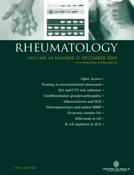-
PDF
- Split View
-
Views
-
Cite
Cite
A. A. DEODHAR, A. D. WOOLF, BONE MASS MEASUREMENT AND BONE METABOLISM IN RHEUMATOID ARTHRITIS: A REVIEW, Rheumatology, Volume 35, Issue 4, April 1996, Pages 309–322, https://doi.org/10.1093/rheumatology/35.4.309
Close - Share Icon Share
Abstract
The involvement of bone in rheumatoid arthritis (RA) is well recognized, and hand bone densitometry appears to be a promising new technique to monitor disease progression by assessing serial changes in hand bone mass in patients with RA. New biochemical markers of bone formation (i.e. osteocalcin) show contradictory results in different studies, although markers of bone resorption (i.e. urinary collagen cross-links) have shown significant increase in patients with RA. Bone histomorphometric studies suggest that the periarticular osteopenia in RA could be related to increased bone turnover locally, whereas generalized osteoporosis could be due to a global negative remodelling balance. The important factors implicated in the pathogenesis of the bone loss are circulating cytokines [e.g. tumour necrosis factor alpha (TNFα), interleukin (IL) 1 and IL6] produced by the inflammatory process, use of oral corticosteroids (in the dose of ≧ 5 mg) and reduced mobility due to functional impairment. Apart from this underlying osteoporosis, patients with RA have an increased risk of falls secondary to functional impairment and there is an increased risk of fractures in patients with RA. Very few studies are presently available looking at the therapeutic measures to prevent osteoporosis in RA. Future drug trials on the treatment of RA should include bone mass measurement, especially of the hand, as one of the outcome measures.
- cytokine
- osteoporosis
- rheumatoid arthritis
- adrenal corticosteroids
- bone mineral density
- biochemical markers
- fractures
- glucocorticoids
- bone resorption
- collagen
- disease progression
- interleukins
- osteogenesis
- urinary tract
- interleukin-6
- mineralocorticoids
- osteocalcin
- osteopenia
- bone turnover rate
- bone metabolism
- bone densitometry
- outcome measures
- functional impairment
- mobility
- tumor necrosis factor-alpha
- fall risks
- periarticular osteopenia




Comments